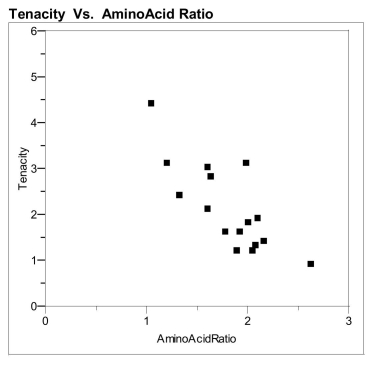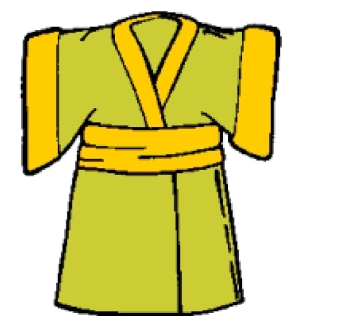a) What is the equation of the least-squares
line for predicting tenacity using amino
b) Graph the least squares best fit line on the scatter plot
that appears on the next page.
acid ratio Amino acid ratio and tenacity for linings for 16 Japanese kimonos
c) Approximately what proportion of the variability in
tenacity is explained by the linear relationship
between tenacity and the amino acid ratio? The theory of fiber strength suggests that the relationship between fiber tenacity and amino acid ratio is logarithmic, i.e. , where is the tenacity and is the amino acid ratio. Perform the appropriate transformation of variable(s) and fit this logarithmic model to the data.  protein and biodegradable. It would be beneficial
protein and biodegradable. It would be beneficial
to be able to assess the delicacy of a fabric before
making decisions about displaying it in a
museum. Chemical analysis might give some
evidence about the brittle nature of a fabric. Bio-
chemical data were acquired from the linings of
Some delicate fabrics are natural silks, made of  sixteen 19th and early 20th century Japanese
sixteen 19th and early 20th century Japanese
kimonos. Investigators measured the
concentration of certain amino acids ("Amino
acid ratio") as well as the breaking stress
("tenacity") of the 16 kimono fabrics.
Definitions:
Directions
Instructions or guidelines on how to do something or the route that must be taken to reach a destination.
SQ3R Means
An acronym that stands for the five steps of an effective reading strategy: Survey, Question, Read, Recite, and Review, designed to improve understanding and retention of information.
Survey
A method of gathering information from individuals, usually by asking a series of questions to collect data for analysis.
Anthropology Course
A structured program of study focusing on human societies, cultures, and their development.
Q7: Use power series to solve the
Q14: The slope of the least squares line
Q27: Find the curl of the vector
Q27: Two samples are said to be independent
Q27: A company provides portable walkie-talkies to
Q28: Find the work done by the
Q35: A hypothesis test uses population data to
Q35: Determine whether <span class="ql-formula" data-value="\mathbf
Q38: The Addition Rule states that for
Q90: Use Stokes' Theorem to evaluate